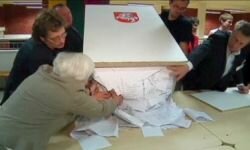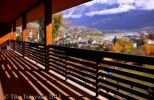ONE OF THE HISTORIC MUSEUMS OF TBILISI IS IN DANGER
06 September, 2013
 Old clandestine printing house that was set up by Joseph Stalin and which is located in the Avlabari district, is in danger. Because of the ground waters, its interior and exponents are being damaged. Without due attention, it may be too late to save it.
Old clandestine printing house that was set up by Joseph Stalin and which is located in the Avlabari district, is in danger. Because of the ground waters, its interior and exponents are being damaged. Without due attention, it may be too late to save it.Joseph Stalin, the leader of the Soviet Union (family name – Jugashvili) was born in the town of Gori in Georgia in 1878. He graduated from the Gori Theological Seminary and entered the Theological Seminary of Tbilisi. Soon, he joined the revolutionary movement under the influence of Russian Marxists.
In 1899, Joseph Jugashvili was fired from the seminary as a result of his revolutionary activity, after which he started an illegal way of life and became a professional revolutioner.
From April 5, 1902 to November of 1903, being an inmate of Batumi and Kutaisi jails, he managed to head the revolutionary social-democratic oraganization of the South Caucasus.
Compiling, publishing and disseminating of illegal literature was an important weapon in the revolutionary struggle. To that end, in 1900, he was instrumental in founding a small illegal printing house in Tbilisi. Later, from the Kutaisi prison, Joseph Jugashvili instructed the revolutionary committee in Tbilisi regarding setting up of a powerful illegal printing house that would print the literature needed by the party and revolution in large quantities. Joseph’s pupil and friend Mikho Bochoridze was assigned to organize the printing house.
In January of 1904, Joseph Jugashvili escaped from the exile in Irkutski, Cyberia, returned to Tbilisi and personally engaged in the activities related to the printing house.
His Avlabari illegal printing house played a significant role in the history of revolutionary movement, embodying the smithery of revolutionary words – an influential source of spreading the revolutionary ideas as well as the global proletarian doctrine. The newspapers and proclamations produced in that printing house were published in Russian, Georgian, Azeri and Armenian languages; they were spread throughout the continent of Eurasian continent.
Proclamations were spread in the following manner: the street greengrocers would call on the printing house with their carts and they would take away the printed material to the Wine Ascent, from which the members of the Revolutionary Committee would transport illegal literature to the railroad station, from which they were taken to different places of the world.
In 1906, the king's gendarmerie accidently came upon the existence of the printing house. George Gurdjieff, one of the greatest mystics of the 20th century, was also somehow involved in this operation of the gendarmerie; he was infiltrated into the group of revolutionaries as a police agent.
Later on, after the establishment of the Soviet rule in 1937, under the leadership of Lavrenti Beria, the reconstruction of the printing house as well as of the conspirational house of the revolutionaries was carried out.
The revolutionaries used to get down to the printing house by means of two burrows – 17-meter-wide and 15-meter-deep tunnels through which they reached the room via the entry located at the height of 8 meters. It is worthy to mention that design and construction of the premises was done by non-professonals – members of proletarian committee.
At present, the printing house functions as a museum; and it is in a
poor condition. The rain water leaks from the ceiling and ruins the historic interior and the exponents. The printhouse room and the printing machine itself are damaged by ground waters.
It will be unpardonable if such a nice building with a certian historic value is ruined. It seems timely to start a campaign to rescue it. The museum needs an urgent attention.





















































